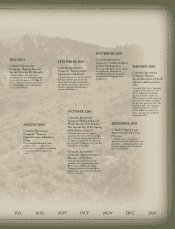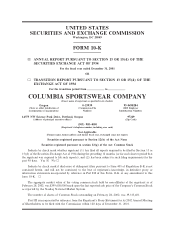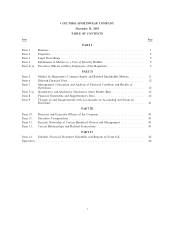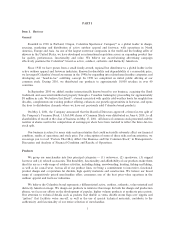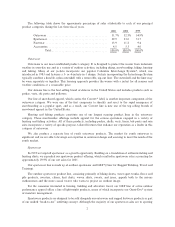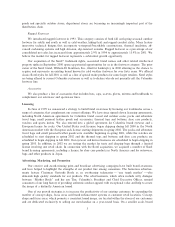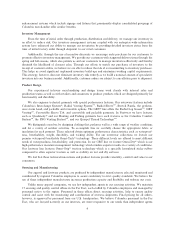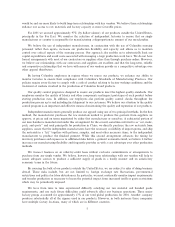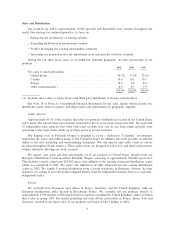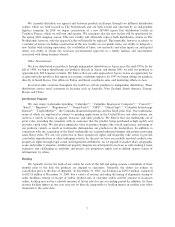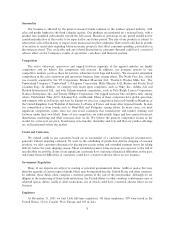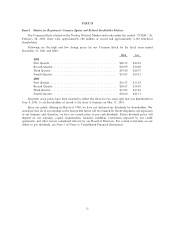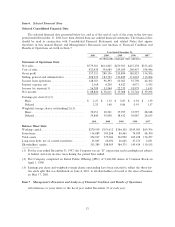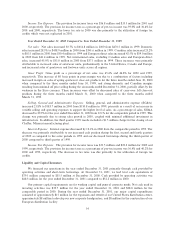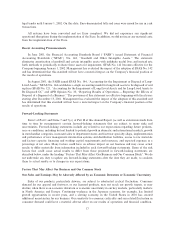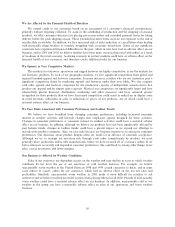Columbia Sportswear 2001 Annual Report Download - page 14
Download and view the complete annual report
Please find page 14 of the 2001 Columbia Sportswear annual report below. You can navigate through the pages in the report by either clicking on the pages listed below, or by using the keyword search tool below to find specific information within the annual report.Seasonality
Our business is aÅected by the general seasonal trends common to the outdoor apparel industry, with
sales and proÑts highest in the third calendar quarter. Our products are marketed on a seasonal basis, with a
product mix weighted substantially toward the fall season. Results of operations in any period should not be
considered indicative of the results to be expected for any future period. The sale of our products is subject to
substantial cyclical Öuctuation or impact from unseasonal weather conditions. Sales tend to decline in periods
of recession or uncertainty regarding future economic prospects that aÅect consumer spending, particularly on
discretionary items. This cyclicality and any related Öuctuation in consumer demand could have a material
adverse eÅect on the Company's results of operations, cash Öows and Ñnancial position.
Competition
The active outerwear, sportswear and rugged footwear segments of the apparel industry are highly
competitive and we believe this competition will increase. In addition, our licensees operate in very
competitive markets (such as those for watches, adventure travel bags and hosiery). We encounter substantial
competition in the active outerwear and sportswear business from, among others, The North Face, Inc., which
was recently acquired by the VF Corporation, Marmot Mountain Ltd., Woolrich Woolen Mills, Inc., The
Timberland Company (""Timberland''), Patagonia Corporation, Helly-Hansen A/S, Burton and PaciÑc Trail
(London Fog). In addition, we compete with major sport companies, such as Nike, Inc., Adidas AG and
Reebok International Ltd., and with fashion-oriented competitors, such as Polo Ralph Lauren Corporation,
Nautica Enterprises, Inc. and Tommy HilÑger Corporation. Our rugged footwear line competes with, among
others, Timberland, Nike ACG, Salomon S.A. and Kamik. Many of these companies have global operations
and compete with us in Europe and Asia. In Europe we also face competition from such brands as Berghaus of
the United Kingdom, Jack Wolfskin of Germany, La Fuma of France and many other regional brands. In Asia
our competition is from brands such as Mont-Bell and Patagonia among others. In many cases, our most
signiÑcant competition comes from our own retail customers that manufacture and market clothing and
footwear under their own labels. Some of our competitors are substantially larger and have greater Ñnancial,
distribution, marketing and other resources than we do. We believe the primary competitive factors in the
market for activewear are price, brand name, functionality, durability and style and that our product oÅerings
are well positioned within the market.
Credit and Collection
We extend credit to our customers based on an assessment of a customer's Ñnancial circumstances,
generally without requiring collateral. To assist in the scheduling of production and the shipping of seasonal
products, we oÅer customers discounts for placing pre-season orders and extended payment terms for taking
delivery before the peak shipping season. These extended payment terms increase our exposure to the risk of
uncollectible receivables. Some of our signiÑcant customers have experienced Ñnancial diÇculties in the past,
and future Ñnancial diÇculties of customers could have a material adverse eÅect on our business.
Government Regulation
Many of our imports are subject to existing or potential governmental duties, tariÅs or quotas that may
limit the quantity of certain types of goods which may be imported into the United States and other countries.
In addition, these duties often comprise a material portion of the cost of the merchandise. Although we are
diligent in the monitoring of these trade restrictions, the United States or other countries could impose new or
adjusted quotas, duties, tariÅs or other restrictions, any of which could have a material adverse eÅect on our
business.
Employees
At December 31, 2001 we had 1,636 full-time employees. Of these employees, 907 were based in the
United States, 102 in Canada, 98 in Europe and 529 in Asia.
8


